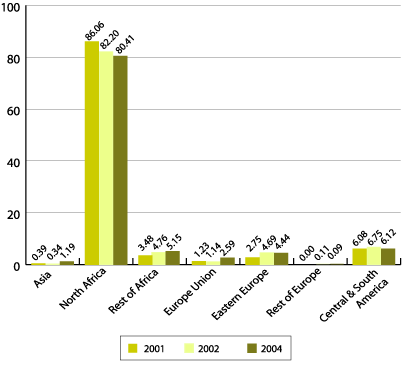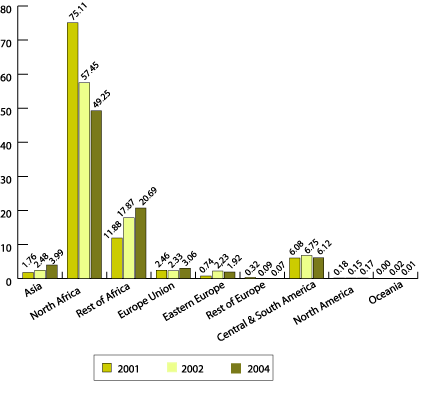
The challenge of the Pilot Plans for increasing knowledge and use of the Catalan language: from knowledge to social use, by Dolors Solà |
||||
| CONTINUA |
Graphic 1. Change over time in the percentage of immigrants from the different subcontinents: a comparison at 12/2001, 12/2002 and 06/2004
Table 5. Reus. Origin of those born outside Spain
Reus has 99,046 inhabitants, of whom 10.42% are immigrants (10,329). In terms of country of origin, the largest group come from Morocco: there are 4,511 Moroccans constituting 43.76% of the total immigrant population. The second largest group are the Colombians (854) followed by people from Ecuador (341). Latin Americans as a whole number 1,837 and make up 17.78% of Reus’s immigrant population. Table 6. Comparative data: the total population and the foreign-born population in the city of Reus in the period November 2002 to December 2003
Table 7. Ulldecona. Origin of those born outside Spain
Interestingly, Ulldecona has an unusually high proportion of immigrants from the countries of Eastern Europe –half the immigrant population in fact. Just over a quarter of immigrants are from the second largest group, those from North Africa (the Magreb).They are from Morocco and speak Amazigh (Berber). Table 8. Vic. Origin of those born outside Spain
Graphic 2. Change over time: breakdown of immigrants per subcontinent in Vic with figures at three specific moments: 12/2001, 12/2002 and 06/2004
The criteria which were born in mind when choosing the municipal areas were:
The fact of an area being selected for the Pilot Plans in question does not indicate any kind of preference whatsoever, but simply the opportunity to assist with a project which will provide valuable experience for other areas to draw upon, once the results have been evaluated, corrections and adaptations applied if necessary, with the overall aim of making the Catalan language the common language in this country. 5. Organisations participating Organisations involved in the Pilot Plans are:
6. Reference document for the Pilot Plan for increasing knowledge and use of the Catalan language The Pilot Plans for increasing knowledge and use of Catalan are based on a document providing the same structure for each individual Pilot Plan. This basic scheme was as follows:6.1. Sociolinguistic information on the municipal area In this section the object is to obtain sociolinguistic information in the municipality, from the general census: information on the population in terms of the four basic language skills –understanding, speaking, reading and writing, the origin of the immigrant population and proportion of population in percentages...-, on the basis of such information it will be possibletoanalyse results and provide a basis for putting into writingthe main aims of the project. 6.2. Knowledge of surroundings The general objective here is to obtain information on all bodies and organisations in each of the municipal areas to be able to include them in the project. Specific objectives here are:
Bodies and organisations working together to further the aims of the project are: Local administration, whether county/territorial or autonomous region tier; immigrant organisations; NGOs and similar organisations; adult education; official language schools; Department of Education centres (CEIP and IES); educational services; AMPAS (parent-teacher organisations); school workshops... The indicators literally indicate the results of the coordination with the organisations and the response to the project. The teaching of the Catalan language carried out within the Pilot Plan has to be based on at least the following three criteria:
The activities that are planned need to be framed according to the following scheme:
Activities plannedin common in the pilot schemes are: |
|||||||||||||||||||||||||||||||||||||||||||||||||||||

